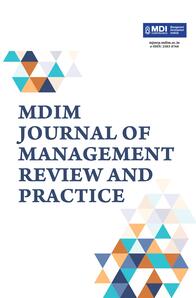
1 Department of Business Management, HNB Garhwal (A Central) University, Srinagar, Uttarakhand, India
Creative Commons Non Commercial CC BY-NC: This article is distributed under the terms of the Creative Commons Attribution-NonCommercial 4.0 License (http://www.creativecommons.org/licenses/by-nc/4.0/) which permits non-Commercial use, reproduction and distribution of the work without further permission provided the original work is attributed.
To stay ahead of market movements and constantly changing stakeholder’s priorities, it is critical for industry moguls and employees to constantly scan for real-time insights into a highly volatile market. A profound shift towards digital transformation during the ongoing pandemic opened a new era of agility in the business sector and acted as an indispensable ingredient for redrafting plans and strategies in a new normal due to that the term “Agile” became a most popular buzzword in the corporate world. The turbulent market impacted every corner of the industry irrespective of size and type of business and compelled them to shift their focus from scale to pace. The pandemic forces us to expedite strategic plans according to the market change to be sustained and not being thrown out by subversive competitors. Therefore, it is recommended to develop tools and models to invigorate the organization from a volatile market through four steps from scratch continuous scanning, orienting the situation faced and finalizing strategy, and working on the action plan. Companies who are aligned with the time and their strategy will lead the market and get competitive advantages over the acute disruption and also be positioned at the top of the K-shaped recovery of the economy. This article is an attempt to provide an insight into agile practices and their managerial implications at the organizational level.
Agile business practice, COVID-19, K shaped recovery, digital transformation, agile strategy
Introduction
“In this new world, it is not the big fish which eats the small fish;
It’s the fast fish which eats the slow fish.”
—Klaus Schwab, Founder and Executive Chairman,
World Economic Forum.
The word “Agile” is not a new phenomenon in the business world but it became more popularized during a pandemic due to its basic characteristics which describe continuous improvement and adaptation of new technologies or plans according to changes in customer needs and feedback (Arshad et al., 2022; Wang et al., 2022). Stalk and Stewart (2019) stated that the traditional strategic planning process will not help to fast execution and building an agile organization. He also argued that the Pandemic induced a change in the process of annual strategic planning with the current and strategic planning which is based on fresh market insights and focuses on the tools and models to stimulate agile behavior across the business landscape. In the new era of agile practices, large-size companies threaten to disrupt new, small and fast-moving companies. Stalk & Stewart argued that in the current cut-throat competition landscape, time to deliver to market is more important than size and scale. A few studies revealed that organizations that preferably opted for agile methods are more empowered in the context of employees and asset management which stimulates creativity and innovation in the decision-making process (Alzoubi et al., 2022; Rigby et al., 2018). Agile is manifested with great communication and collaboration among team members with gradual planning and high flexibility in the ongoing changes in the marketplace and customer needs (Dutton, 2018). Moreover, COVID-19 pandemic persuaded many businesses to undergo digital transformation with a prophetic warning to the laggards for a new normal life as only an agile framework can provide better assistance in the era of chronic disruption as it has ripple effects that trajectory segmenting the economy into two parts are widely known as K shaped recovery of an economy. A study (Deloitte, 2020) report identified that organizations that are digitally sound tend to focus on multiple iterations and constant affirmation to adopt agile methods over the less digitally matured organization. Therefore, those organizations which are not digitally mature face more ambiguity and vagueness to channelize agile frameworks within the organization which leads to falling under the bottom of K such as hospitality companies, travel, and tourism, restaurants while others are vice-versa. They are more equipped with techno parts and quickly administer value-based outcomes such as Zoom, Netflix, TikTok, and PayPal (Weichbroth, 2022). In a (State of Agile, 2021) report findings show that there is a significant outrageous growth in the adoption of the agile strategy in software/IT companies which increased from 37% in 2020 to 86% in 2021 while non-IT companies also have significantly doubled in adopting agile framework within the organization comparing to the last year.
How Agile Benefited to Build an Invigorating Strategy?
“We placed a focus on the business and transforming how we work first and foremost. We used that as a catalyst to begin to drive agility through the organization—speed of decision making, clarity of focus on purpose, showing that we can deliver incremental value—without forgoing the larger picture.”
—David Paine, Domain Information Office Toyota Financial Services
The global epidemic spread out in early 2020 opens a new challenge and threat to the companies to sustain and perform in a complete lockdown condition which instigates the organization to move for digital transformation and create a new opportunity for many young and small companies to adopt agile practices in building business strategy as well as operational execution (Benlian, 2022). The agile framework instigates collaboration and communication between team members and stakeholders and provides a dynamic outlook of business practices due to its systematic approach and consistent development (Mueller & Benlian, 2022; Oladinrin et al., 2022; Reich & Peppard, 2022; Röglinger et al., 2022). The agile methodology ensures fixing any issues immediately at the particular instance and deliberates the process smoothly from its foundational stages. Figure 1 depicts the flow chart of agile methodology for a better understanding of agile processes to pursue by an organization.
Continuous Planning
In response to the COVID-19 epidemic, most companies accelerating their approach to adopting new business practices, processes, and technologies based on the ongoing changes that occurred in market conditions and customer feedback (Figure 1). The “new normal” posed an imperative requirement for continual planning to quickly identify the changing demand of customers and provide active solutions for the same (Aragonés-Jericó & Canales-Ronda, 2022; Flores-Cerna et al., 2022).
Figure 1. Agile Methodology Pipeline.
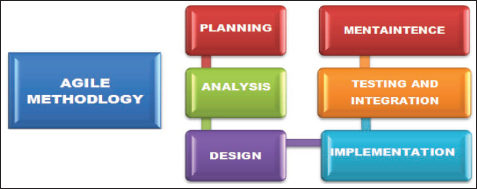
Analysis: Prioritizing Business Tasks
Prioritization of tasks provides subliminal assistance to focus on a gray area for immediate intervention and better outcomes. This process channelizes the task on a need basis and helps to completion of a project at a particular time. Another important role of prioritization is to review a list of tasks on a daily basis and align with the user’s feedback constantly.
Design: Actionable Insights
“Using data and analytics to continuously source promising opportunities or solutions to problems in real-time, deploying tests quickly, evaluating the results, and rapidly iterating.”
—McKinsey, 2016
Agile companies use the database for proactive decisions which provide a significant level of insights not for creating a baseline only but also to provide a comprehensive outlook of the condition that prevailed in that project.
Maintenance: Real-time Outcome
The most difficult task is to maintain and retain performance irrespective of the market condition, and competitors’ strategies applied by your rivalries. Being an agile company helps you to lift and optimize priorities according to the needs of the project and provide better assistance to be sustained even in times of turmoil.
Testing and Integration: Process of Learning
The process of learning is initiated with internal testing and integration which help to know the needs of potential customers and revenue opportunities in a particular market condition and also channel the growth opportunities within the process of learning.
Implementation: Focused Team
Planning is the first and foremost task needed either to test or learn as it replaces the chance of not knowing, learning but without execution your planning will not be in action. Therefore, it is necessary for every individual within the organization either operation manager, strategic decision-maker, or individual contributor, all be equally responsible for the execution and implementation of tasks/projects in real-time with value-based outcomes.
Being Agile Is Not Easy
Composition of Agile Approach “5 Ps.”
In response to the COVID disruption, many organizations set a trend to work from remote areas on behalf of the companies. A report by the State of Agile, July 2021, found that only 3% of employees of a software company were planning to go back to the office full time whereas, 25% of the respondents prefer to work remotely even post-COVID period. The study also revealed that 56% of respondents are in favor of a hybrid approach, they can return to the office on a need basis but not daily. Companies working with an agile framework address the issue on an immediate basis and are not allowed COVID-19 to hamper the performance of an organization and the revenue itself. The aforementioned building blocks are the keys to being a sustainable organization in a period of chronic disruption. However, these 5Ps provide better assistance to drive the organization on the said path. These 5Ps are well known as People, plan, process, platform, and performance.
People
Traditionally, leaders believe in sharing tasks with their employees and constantly monitoring the same to achieve the desired outcomes but now a paradigm shift has come into this approach and today’s organizational leaders delegate full responsibility and accountability for the task to empower the employees and provide complete access to perform their best with the freedom of decision-making process towards the fulfilment of organizational goals and objectives (Saarikallio & Tyrväinen, 2022). Putting the people at the center of the organization leads to innovative, quick, and effective outcomes. The fundamental objective of agile is to make clarity of the role and goal. If the employee well understands and is clear about the vision and mission of an organization along with their responsibility and accountability then an organization reaches the first milestone of an agile framework. In most organizations that follow Agile practices, employees take ownership of goals set by the team and their higher management, decisions to achieve those goals, and performance of individuals for achieving these targets by exhibiting entrepreneurial skills. In this technological era, employees have to proactively upgrade their soft and hard skills and continuously pursue new challenges and opportunities to get jobs ready in the market. New-age companies seek self-motivated talent, invest in the growth of their carrier upgrade skills, and aim for excellence. The agile model also inspires companies to upgrade the skills of their workforce by way of the talent development department (Marnewick & Marnewick, 2022). Nowadays companies instead of hiring talent from outside prefer to encourage and skill up their existing resources and provide the option to choose internal mobility so that their prior experience can add value on top of a new skill that was acquired over a while. Internal mobility is something that facilitates the existing workforce to move internally across different projects both vertically and horizontally. There is software that is being used in organizations to keep track of open positions, and roles and track the talent pipeline. This way individuals can target to achieve and set their carrier goals and aspirations while organizations are getting benefitted by saving their costs on hiring, induction, cultural fit, and professional fit for new resources from an outside organization.
Plan
The agile organization encourages their employees to share strategic input for delivering the task at hand and also instigates to keep sight on any external changes in the environment or customer preference to shape and iterate to new initiatives or build business models for unforeseen changes in the market.
In an Agile environment, there are nimble and smart teams that are self-sufficient to drive the customer target and expectations. These teams are called Agile Squads where the Squads run to achieve a specific goal that keeps on changing as per customer preference and external environment. Agile Squads have various roles like Scrum Master, Product Owner, Development Lead, Lead Analyst, Quality and Assurance folks, Business Analyst. Squads seek stakeholder feedback on regular intervals by way of product demos, sprint demos, sprint retrospection, crowdsourcing, and hackathons. These squads use a variety of tools to capture customer journey maps to identify new opportunities and provide ultimate satisfaction. These Squads also keep track of the progress and check the pulse of their commitments sprint over sprint. These companies majorly set up the Centre of Excellence for new initiatives, and pilot launches and allocate these resources for innovations and most demanding areas to ripen the profits (Ndlela & Tanner, 2022). Product-based organizations like Netflix, Uber, Google, Microsoft, Amazon, Facebook, and so on, either try to grow organically by developing in-house tools and continuously improving those or in-organically by way of acquisitions to strengthen their market presence. This helps them to reduce their cost and capture market space with their competitors. Most of the decisions taken for acquisitions are taken by top management keeping in mind their vision and mission that will keep those organizations sustainable in a highly competitive global market. The Agile best practices also ensure that every individual feels that they are a key contributor and are directly impacting the delivery and making contributions to achieve customer expectations.
Process and Performance
In the traditional approach where the most experienced individual was responsible for the right outcome and responsible for providing a detailed plan to achieve the outcome keeping in mind to minimize the risk along the way, Agile embraces certain basic assumptions like its onerous prognostication of change in customer demand/need and which will be intact, followed by analysis, design, and testing that are not projected prior on the planning phase (Figure 1). Agile philosophies advocate that processes should be adopted incrementally to manage unpredictability and incorporate changes at a swift pace. It supports quickly trying out things to embrace changing requirements so that risk can be reduced (Saarikallio & Tyrväinen, 2022). Agile processes encourage incremental adaptation that inherently works on the philosophy of getting customer wwwwfeedback at regular intervals based on incremental delivered working software in small chunks (Figure 2). Unlike traditional models where organizations were delivering in a year or two span’s time, most companies, nowadays follow seven days to 15 days of production deployment for their regular updates targeting customer requirements. This helps to drive the change swiftly and get regular feedback every two weeks, thereby reducing the turnaround time. Major global banks like Morgan Stanley, JP Morgan, Goldman Sachs, and so on, have scrapped their project-management office and ventured into product management organizations by changing the thread in this culture from a traditional approach to a minimum viable product-based process that acts as a primary measure of progress. Instead of a single release a year, they have ventured to several thousand releases on monthly basis to gear up product development, continuous integration, and deployment. Even at a later stage of development, agile principles emphasize customer satisfaction via prompt, sustained distribution of working software products keeping in mind the customers’ ever-changing requirements (Figure 2). This is perceived as expanding the client’s competitive advantage. For this to succeed, agile squad members need to have collaboration and coordination and be available when someone asks for help. All the squad members need to be in sync and focus to get things done in a specified time. Pre-COVID-19, face-to-face communication was the de facto standard for conveying information got replaced with online meeting apps (like Zoom, Google Meet, Skype, Microsoft Teams, etc.) after COVID-19 within the squad. While being self-organizing, the primary objective of these squads is to deliver a quality product by utilizing state-of-the-art architecture, design, and showcase and incorporating the feedback received at regular intervals through retrospections (Sharma et al., 2022). There exist various agile models named Agile Modeling, Adaptive Software Development, Scrum, Kanban, Feature Driven Development Extreme Programming, and so on, but mostly Scrum is prevalent in the Indian marketplace. For value delivery, a high-performing squad should have certain attributes like value-driven development, mutual trust, unified outlook, respect, collaboration, competencies, and timely acceptance and improvement based on continuous feedback. Several squad ceremonies act as a pulse check for the overall health of the sprint right from backlog refinement, sprint planning, daily scrum, review, and sprint retrospection to name a few.
In a typical agile squad, there are different roles and corresponding responsibilities tied to such roles as Product Owner, Agile Coach, Scrum Master, Vertical Lead, Lead, CoE Lead, and so on. The agile process requires a minimum of four roles to be effective as per below (Figure 3).
The Product Owner is at the core of the squad that defines the overall strategy and direction of the product and ensures organizational alignment with stakeholders. They communicate stakeholders’ needs in the form of user stories and product backlogs. The Scrum Master facilitates the process to ensure the squad delivers outcomes. They foster a collaborative culture and ensure the squad regularly celebrates success. The Agile Coach ensures that Squads are following agile processes in each sprint by observing, consulting, and providing feedback for improvement. They are responsible for regularly assessing team maturity and providing action plans for improvement. The Agile Squad works on building product features to deliver outcomes in line with the customer’s needs. This comprises a cross-functional group of people who get stuff done. They escalate issues early and often so that the scrum master and product owner can remove any hindrances or roadblocks. An Agile Squad interacts with several internal & external stakeholders. Agile squad encourages creating an environment where everyone raises their concern and discusses an open platform with complete transparency (Figure 4).
Platform
Technology has gotten its feet in whatever we do in the present time. Organizations are trying hard to integrate all facets flawlessly to unlatch the value that can cater to the changing priorities and demands of the stakeholders. As the agile organization has to provide products and services that can embrace change and act rapidly on those, therefore, it is crucial to have everything digitalized or digitally enabled and proper monitoring and alert mechanisms for such systems should be in place. New advancements like Big Data, IoT, Data Science, Artificial Intelligence, Machine Learning, Cloud-Based architecture, Micro-Services, Kafka based systems should be used in the development and delivery practices into the business to cater growing demands of the users (Sharma et al., 2022).
Figure 2. The Sprint Cycle Explained.
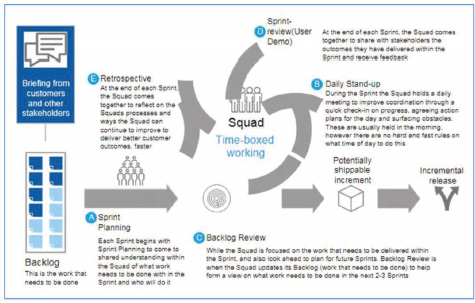
Figure 3. Typical Squad Core Roles.
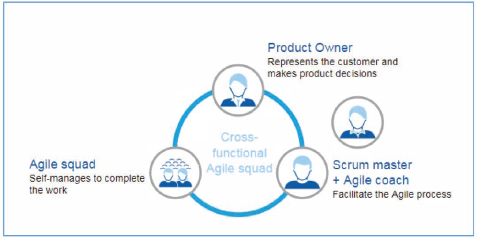
Figure 4. Spotify Squad Framework.]
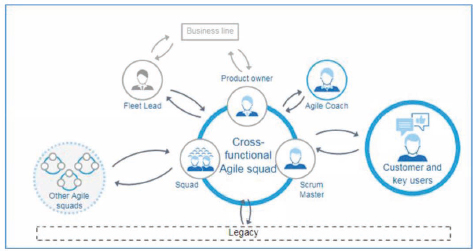
Source: https://www.thescrummaster.co.uk/agile-scrum-the-spotify-model/
Conclusion
Agile is the new default way of working in the current dynamic and rapidly evolving business environment that enables organizations to stay competitive and market-ready for survival. It can be coined as a new mindset for companies based on common values and principles to achieve the best possible outcomes for the customers. As modern markets face unprecedented uncertainty, therefore, it is very much necessary for companies to be agile in developing an immune system that can help them to adjust, adapt and respond to any unexpected changes while remaining competitive within the marketplace. This also helps in fostering a culture of collaboration in agile teams. This is the prime reason why Organizations are rushing to adopt agile development methodologies across the world.
Declaration of Conflicting Interests
The author declared no potential conflicts of interest with respect to the research, authorship and/or publication of this article.
Funding
The author received no financial support for the research, authorship and/or publication of this article.
Aghina, W., Ahlbäck, K., De Smet, A., Fahrbach, C., Handscomb, C., Lackey, G., Lurie, M., Murarka, M., Salo, O., Seem, E., & Woxholth, J. (2018). The five trademarks of agile organizations, Written collaboratively by McKinsey Agile Tribe, December 2017. https://www.mckinsey.com/capabilities/people-and-organizational-performance/our-insights/the-five-trademarks-of-agile-organizations
Alzoubi, H. M., Elrehail, H., Hanaysha, J. R., Al-Gasaymeh, A., & Al-Adaileh, R. (2022). The role of supply chain integration and agile practices in improving lead time during the COVID-19 crisis. International Journal of Service Science, Management, Engineering, and Technology (IJSSMET), 13(1), 1–11.
Annual Agile Report. (July 2021). “15th State of Agile Report”. https://explore.digital.ai/state-of-agile/15th-state-of-agile-report.
Aragonés-Jericó, C., & Canales-Ronda, P. (2022). Agile learning in marketing: Scrum in higher education. Journal of Management and Business Education, 5(4), 345–360.
Arshad, N. I., Bosua, R., Milton, S., Mahmood, A. K., Zainal-Abidin, A. I., Ariffin, M. M., & Aszemi, N. M. (2022). A sustainable enterprise content management technologies use framework supporting agile business processes. Knowledge Management Research & Practice, 20(1), 123–140.
Benlian, A. (2022). Sprint zeal or sprint fatigue? The benefits and burdens of agile ISD practices use for developer well-being. Information Systems Research, 33(2), 557–578.
Deloitte Insights. (2020). Digital transformation. https://www2.deloitte.com/us/en/insights/topics/digital-transformation.html.
Dutton, G. (2018). Choosing the right agile strategy. Training Magazine. https://trainingmag.com/choosing-the-right-agile-strategy/
Flores-Cerna, F., Sanhueza-Salazar, V. M., Valdés-González, H. M., & Reyes-Bozo, L. (2022). Agile methodologies: An analysis of the organizational challenges for their implementation. Revista Científica. https://doi.org/10.14483/23448350.18332
Marnewick, C., & Marnewick, A. L. (2022). Benefits realisation in an agile environment. International Journal of Project Management, 40(4), 454–465.
Mueller, L., & Benlian, A. (2022). Too drained from being agile? The self-regulatory effects of agile ISD practices use and their consequences for turnover intention. Journal of the Association for Information Systems, 23(6), 1420–1455.
Ndlela, M., & Tanner, M. (2022). Business analysts’ contributions to the dynamic capabilities of agile software development teams. Information Technology & People, 36(8). https://doi.org/10.1108/ITP-08-2021-0656
Oladinrin, O. T., Jayantha, W. M., & Ojo, L. D. (2022). New work practices and their drivers in FIREB firms: Evidence from Hong Kong. Journal of Corporate Real Estate. https://doi.org/10.1108/JCRE-04-2022-0008
Reich, B. H., & Peppard, J. (2022). Realizing value from digital transformation: Benefits management re-imagined. In 2022 Portland International Conference on Management of Engineering and Technology (PICMET) (pp. 1–8). IEEE.
Rigby, D. K., Sutherland, J., & Noble, A. (2018). Agile at scale. Harvard Business Review. https://hbr.org/2018/05/agile-at-scale
Röglinger, M., Plattfaut, R., Borghoff, V., Kerpedzhiev, G., Becker, J., Beverungen, D., vom Brocke, J., Van Looy, A., del-Río-Ortega, A., Rinderle-Ma, S., Rosemann, M., Maria Santoro, F., & Trkman, P. (2022). Exogenous shocks and business process management. Business & Information Systems Engineering, 64, 669–687.
Saarikallio, M., & Tyrväinen, P. (2022). Quality culture boosts agile transformation—Action research in a business-to-business software business. Journal of Software: Evolution and Process, 35(1), e2504.
Sharma, M., Luthra, S., Joshi, S., & Joshi, H. (2022). Challenges to agile project management during COVID-19 pandemic: An emerging economy perspective. Operations Management Research, 15, 461–474.
Stalk, G., & Stewart, S. (2019). Avoiding disruption required rapid decision making. Harvard Business Review. https://hbr.org/2019/04/avoiding-disruption-requires-rapid-decision-making
Wang, J., Xu, Y. P., & She, C. (2022). Effect of cloud-based information systems on the agile development of industrial business process management. Journal of Management & Organization. https://doi.org/10.1017/jmo.2022.49
Weichbroth, P. (2022). A case study on implementing agile techniques and practices: Rationale, benefits, barriers and business implications for hardware development. Applied Sciences, 12(17), 8457.